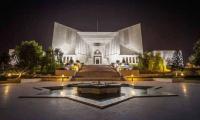The ideal situation should be that the moment a rule is made by the executive it is reviewed by the legislature and the superior judiciary to decide if it is as per the provisions and dictates of the parent law rather than waiting for a party to approach the court in a CP. This will also eliminate unnecessary litigations.
To run the affairs of the state, the executive establishes various ministries, authorities, departments and autonomous bodies in the light of these laws made by the legislature and its rules.
If a public functionary does not work as per law – that is: issues unlawful show-cause-notices or passes illegal orders – then the people are at liberty to challenge the illegal action before the high court in a CP.
As the executive is empowered by the legislature to prepare rules to implement a law, therefore instead of the CP before the high court, first a complaint should be made to the relevant assembly to seek its opinion on whether the executive has correctly developed the rules to implement the law as per the objective of the law made by the legislature.
The legislature has also established various ombudsmen – federal, tax, provincial, banking etc. These ombudsmen are like compliance officers in banks to mitigate violation of law in various transactions/activities then and there.
For fiscal and other matters there are various adjudication forums like assessing officers, commissioner-appeals, tribunals and civil suits – for recovery, possession, declaration, direction, injunction etc – which are filed in the district courts wherein the district judge is required to decide the matter as per law considering the facts. However, if a judgment by the ‘subordinate judiciary’ is not as per the dictates of law, then appeals are filed before the superior judiciary.
From the above it is clear that the responsibility of the executive is not only to implement the law through the bureaucracy and law-enforcement agencies but also to adjudicate the disputes through the subordinate judiciary; the subordinate judiciary and judicial forums act as independent checks on the bureaucracy and law-enforcement agencies as it is the basic responsibility of the executive to provide justice to the citizens.
It is pertinent to note that except the Sindh High Court at Karachi (SHC-K), high courts all over Pakistan, being part of the superior judiciary, exclusively preside over matters that fall within the jurisdiction of Article 199 (constitutional) and 203 (superintendence of subordinate judiciary) but due to the limited pecuniary jurisdiction of district courts in Karachi, the SHC-K is the only superior judiciary that is also trying ‘civil suits’ – hence discharging the function of the subordinate judiciary. This is an infringement of the ‘independence of the judiciary’.
Unfortunately, this anomalous and contravening civil jurisdiction of the SHC-K is the legacy of the British Raj in lieu of the Sindh Courts Act, 1926 which continued in Karachi as Karachi was initially the capital of Pakistan. The civil jurisdiction of the SHC-K is in clear violation of the 1973 constitution. It is worth noting that Article 268(3) of the constitution provides that all existing laws (at the time of promulgation of the 1973 constitution) were required to be aligned with the intent of the constitution within two years from the promulgation of the constitution. Hence, the civil jurisdiction of the SHC-K should have been abolished by 1975 at least.
This civil jurisdiction is called ‘original civil jurisdiction’. The constitutional jurisdiction under Article 199 at the Sindh High Court is called ‘extraordinary constitutional jurisdiction’. In fact, the original jurisdiction of the Sindh High Court, like any other high court, is ‘constitutional jurisdiction’ and the ‘civil jurisdiction’ to try civil suits is ‘extraordinary civil jurisdiction’, as it is not given under the constitution.
Further, due to this anomaly, civil suits at the SHC-K are heard by a single bench hence CPs are heard by the Division Bench, while in other high courts CPs, which are called Writ Petitions (WP) there, are heard by a single bench. Due to the hearing of CPs by the Division Bench and civil suits by a single bench, the strength of the honorable judges of the SHC decreases, increasing the volume of pending matters.
The author of this article challenged the vires of the Sindh Amendment in section 7 of the Civil Court Ordinance, 1962 entrusting civil jurisdiction to the SHC-K vide a CP before the SHC. The court disposed of the petition with a direction to the provincial government. The order has further been challenged by the author before the Supreme Court.
In conclusion, to maintain the independence and effectiveness of the superior judiciary as a control over the legislature and the executive, the following needs consideration: one, all constitutional petitions involving legal issues should be decided by the high courts, including the SHC, irrespective of the matter pending before any other forum. The jurisdiction under Article 199 is not an alternative but a parallel jurisdiction to decide legal points.
Two, the jurisdiction of the ‘SHC at Karachi’ to try Civil Suits should be immediately abolished and constitutional petitions at the SHC should be heard by a single bench like high courts in other provinces.
All high courts are established under the constitution but somehow have different jurisdictions and procedures. It is apparently due to this reason that high courts are known under different names, viz Sindh High Court, Lahore High Court, Peshawar High Court, Quetta High Court and Islamabad High Court. Perhaps it may be more suitable to bring uniformity by referring to the high courts as the ‘High Court of Pakistan’ whether at Karachi, Lahore, Peshawar, Quetta or Islamabad as high courts are constitutional courts and not under any province.
Concluded.
The writer is an advocate of the Supreme Court. He can be reached at: emad.hasan@euhlaw.com
On December 21, Trump unleashed fresh salvo, lambasting Panama for its "unfair" canal fees
According to Unicef, estimated 22.8 million children aged 5 to 16 are out of school in Pakistan
Famous Urdu slogan carrying incumbent PM’s name is ‘Shehbaz Karey Parwaz’, which means Shehbaz is high flier
Gender disparities are pronounced in KP, where girls account for 64% of OOSC
Chinese philosopher Mencius prophesized 3000 years ago that state that does not employ worthy perishes
Over past two decades, rapid and often chaotic development has increasingly defined Islamabad's landscape







